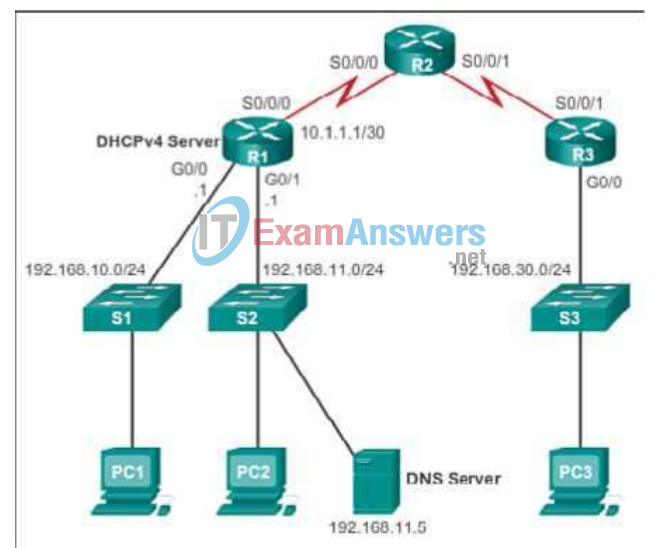CCNA 2 Routing and Switching Essentials v5 Chapter 10: DHCP – Check Your Understanding Questions Answers
1. Which statements are true about the DHCP server functions? (Choose two.)
- When a client requests an IP address, the DHCP server searches the binding table for an entry that matches the client’s MAC address. If an entry exists, the corresponding IP address for the entry is returned to the client.
- Clients can be assigned an IP address from a predefined DHCP pool for a finite lease period.
- DHCP services must be installed on a dedicated network server to define the pool of IP addresses available to the client.
- The DHCP server can answer requests and assign IP addresses for a particular subnet only.
- Each subnet in the network requires a dedicated DHCP server to assign IP addresses to the host on the subnet.
- DHCP provides clients with an IP address, a subnet mask, a default gateway, and optionally, a domain name.
2. Consider the following configuration:
Rl(config)# ip dhcp pool 192.168.10.0
What is the function of the 192.168.10.0 argument?
- Name of the DCHP pool
- Pool of IP addresses available for lease
- Range of excluded IP addresses
- Subnet where the DHCP server resides
3. Which three statements about DHCPv4 are true? (Choose three.)
- DHCP messages use UDP as a transport protocol.
- The DHCPOFFER message is sent by a DHCP server after receiving a DHCPDISCOVER message from a client.
- DHCP uses ports 67 and 68.
- The DHCPREQUEST message is sent by a DHCP client to locate a DHCP server.
- The DHCPACK message is sent by the DHCP server to provide the DHCP client with the DHCP server MAC address for further communications.
- All DHCP communications are broadcast.
4. Refer to the exhibit. If PC3 used R1 as a DHCPv4 server, on what interface would the ip helper-address be configured?

- R3 S0/0/0
- Any interface on R3
- R3 S0/0/1
- R3 G0/0
5. If a DHCPv6 client resides on subnet 192.168.30.0/24 and the DHCPv6 server resides on subnet 192.168.10.0/24, why is it necessary for a DHCPv6 Relay Agent?
- Because DHCPv6 does not use broadcasts
- Because a DHCPv6 client cannot use a DHCP server on a remote network
- Because DHCPv6 messages still need to be relayed if the DHCPv6 server resides on a different network
- Because DHCP v6 messages must be converted to a broadcast to be heard across multiple networks
6. Which two methods of assigning an IPv6 address to a router interface are automatic and can be used in conjunction with one another? (Choose two.)
- EUI-64
- Static assignment
- DNS
- DHCPv6
- Stateless autoconfiguration
7. Place the four DHCPv4 steps in the order they occur. Note that not all options will be used.
DHCPREQUEST
DHCPLEASE
DHCPACK
DHCPDISCOVER
DHCPREPLY
DHCPOFFER
First: _____________________________
Second: ___________________________
Third: _____________________________
Fourth: ____________________________
| First | DHCPDISCOVER |
| Second | DHCPOFFER |
| Third | DHCPREQUEST |
| Fourth | DHCPACK |
8. Which DHCP message types are originated by a DHCPv4 server? (Select all that apply.)
- DHCPREQUEST
- DHCPLEASE
- DHCPACK
- DHCPDISCOVER
- DHCPREPLY
- DHCPOFFER
9. What type of IPv6 message is used by an IPv6 host to automatically obtain an IPv6 address from a router?
- broadcast
- DNS
- RS
- ARP
10. Which DHCPv6 option is most like DHCPv4?
- SLAAC
- Stateful DHCPv6
- Stateless DHCPv6
- EUI-64
11. Match the DHCPv6 command with the purpose. Note that not all options are used.
_______ Enables IPv6 routing.
_______ RA messages sent to an interface with this command indicates that additional information is available from a stateless DHCPv6 server.
_______ Used on a router interface connected to a DHCPv6 client, and the DHCPv6 server is on a different link.
_______ Causes a router interface to request a DHCPv6 address.
_______ RA messages sent to an interface with this command indicates that the client is to obtain IP addressing information from a stateful DHCPv6 server.
- ipv6 nd other-config-flag
- ipv6 dhcp relay destination
- ipv6 dhcp
- ipv6 unicast-routing
- ipv6 nd managed-config-flag
- ipv6 routing
- ipv6 address dhcp
| ipv6 unicast-routing | Enables IPv6 routing. |
| ipv6 nd other-config-flag | RA messages sent to an interface with this command indicates that additional information is available from a stateless DHCPv6 server. |
| ipv6 dhcp relay destination | Used on a router interface connected to a DHCPv6 client, and the DHCPv6 server is on a different link. |
| ipv6 address dhcp | Causes a router interface to request a DHCPv6 address. |
| ipv6 nd managed-config-flag | RA messages sent to an interface with this command indicates that the client is to obtain IP addressing information from a stateful DHCPv6 server. |
12. What are the two port numbers used by DHCPv6? (Choose two.)
- 67
- 68
- 546
- 547
- 1025
- 1026
- 34768
- 34769
